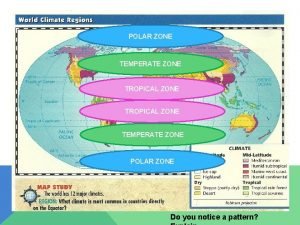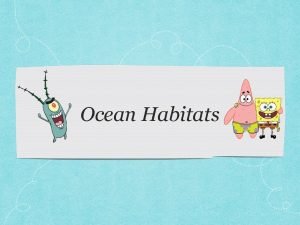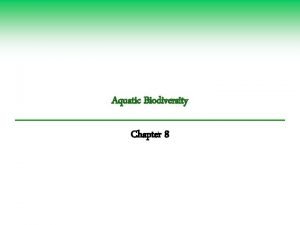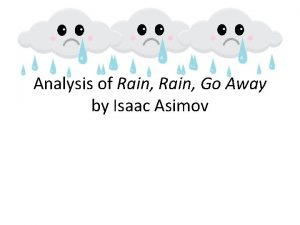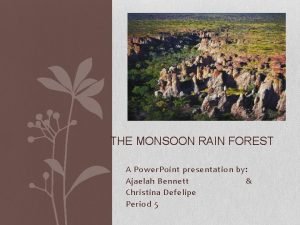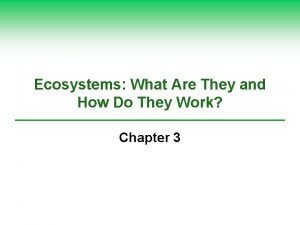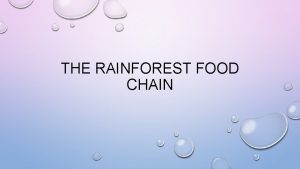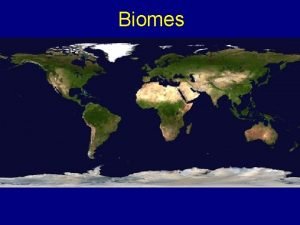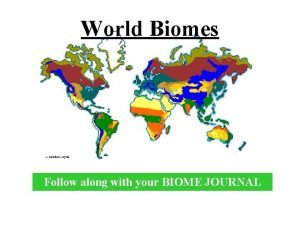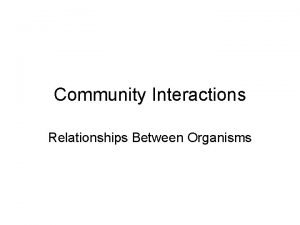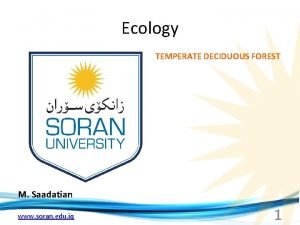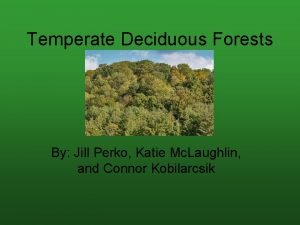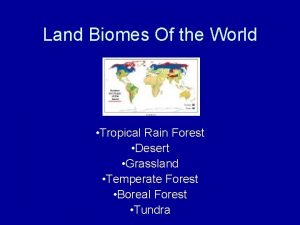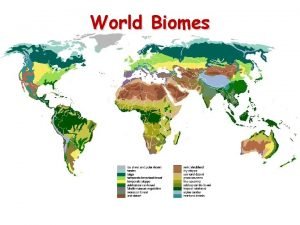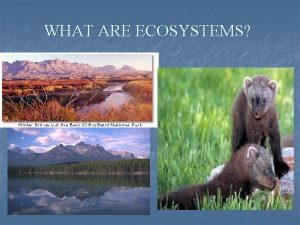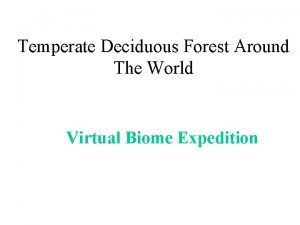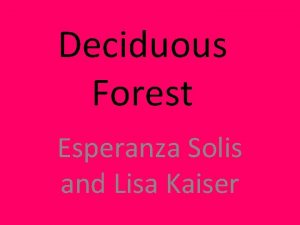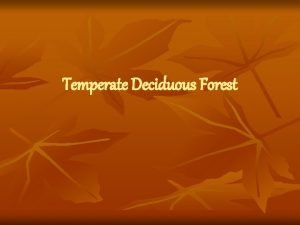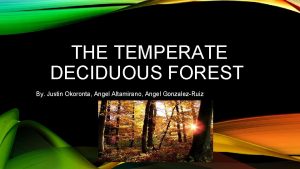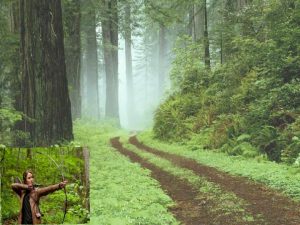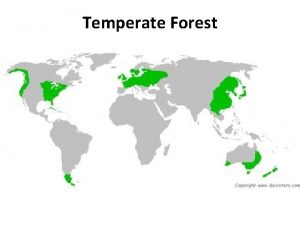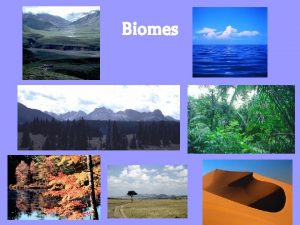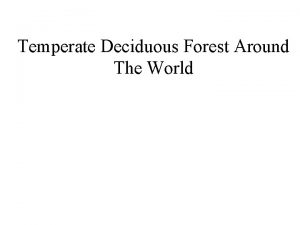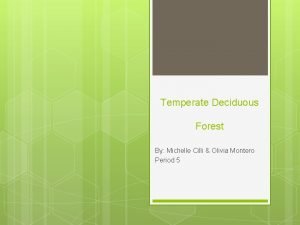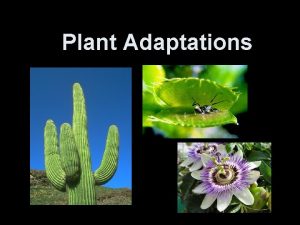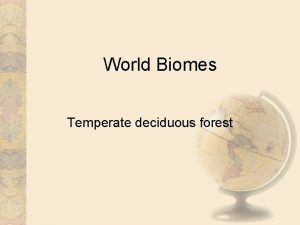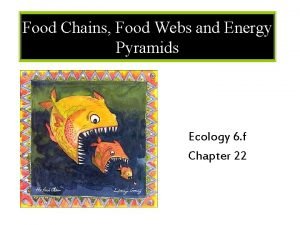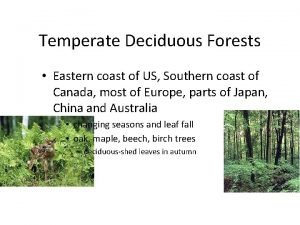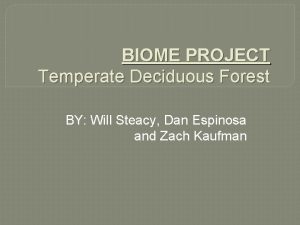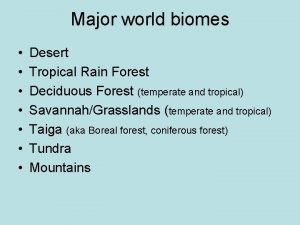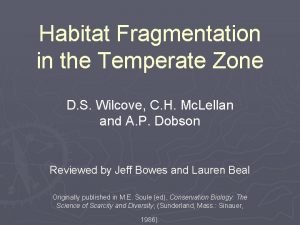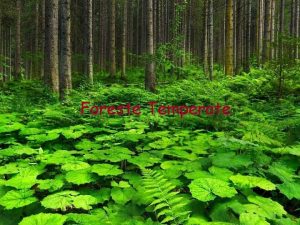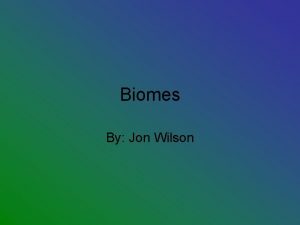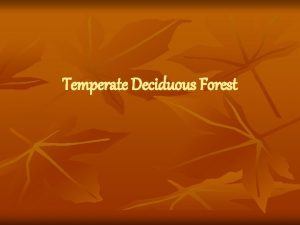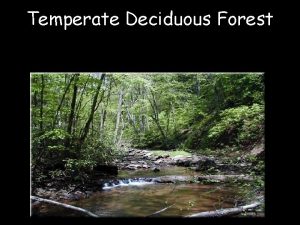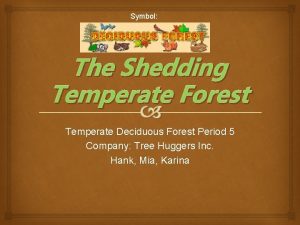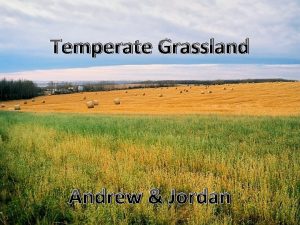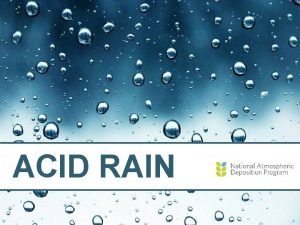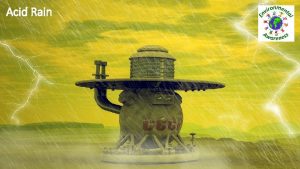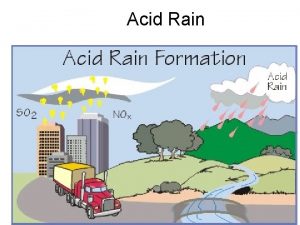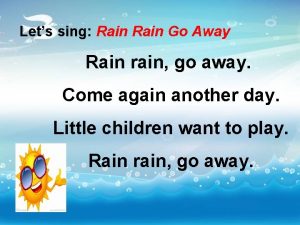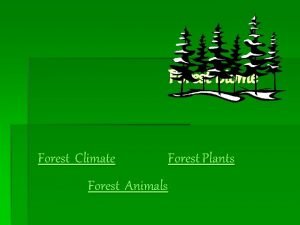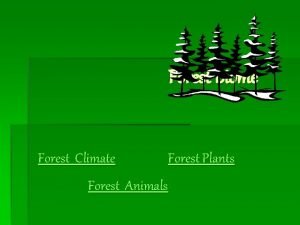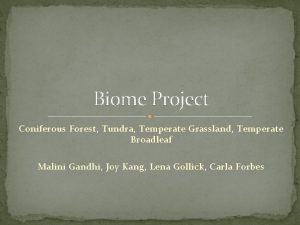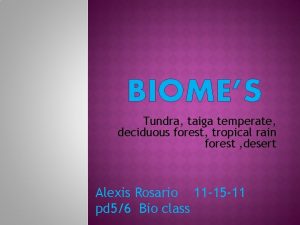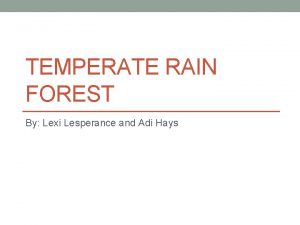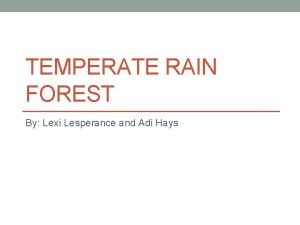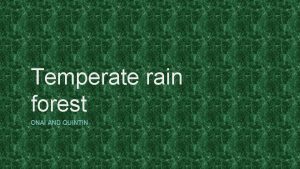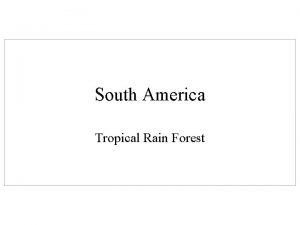Temperate Zone TEMPERATE ZONE Temperate Rain Forest TEMPERATE
































- Slides: 32

Temperate Zone:

TEMPERATE ZONE: Temperate Rain Forest

TEMPERATE ZONE: Temperate Rain Forest TEMP: seasonal but not extreme moderated by coastal currents. Cool 10 C mean. RAINFALL: High but seasonal - dry summer moderated by fogs EVAPOTRANSPIRATIONAL STRESS: low due to fog LIGHT: Seasonally limiting in winter and under closed canopies. SOILS: deep, rich humus layer, rich A horizon. Slow decomposition and shallower bedrock keep nutrients at surface DISTURBANCE: winter, treefalls, storms NUTRIENTS and CYCLING: stalled by winter and dry summer, but otherwise wet.

TEMPERATE ZONE: Temperate Rain Forest BIOTA: Low diversity, but tallest trees on the planet, in NA, hemlock and spruce in north give way to redwoods and sequoia in south Structurally simple; dark understory retards growth of understory except mosses. . . heavy epiphyte load

Temperate Zone: Temperate Deciduous Forest

TEMPERATE ZONE: Temperate Deciduous Forest TEMP: Seasonality is more extreme, with more severely cold winters but moist spring and summer. RAINFALL: More even throughout year; no pronounced drought period. EVAPOTRANSPIRATIONAL STRESS: low for most the year; hot summer and dry winter LIGHT: Seasonally limiting in winter and under closed canopies. SOILS: Soils are rich in nutrients and fairly deep DISTURBANCE: winter, storms, fires on dry substrates NUTRIENTS and CYCLING: Slow but efficient; deep litter layer.

TEMPERATE ZONE: Temperate Deciduous Forest BIOTA: Deciduous trees dominate on good soils; pines dominate on sandy soils, dry slopes, early in succession, and nutrient poor soils. Simple four-layer structure to forest. herbs flower in in spring when light abundant; also when wind-dispersed canopy trees pollinate Biota varies dramatically with climate, from northern hardwoods of Beech and Maple to Southern Poplar-Oak (moist) and Oak-Hickory (dry).

Temperate Zone: Temperate Grassland

TEMPERATE ZONE: Temperate Grasslands TEMP: seasonal extremes - continental climate limits growing season depending on latitude and temperature extremes. RAINFALL: Low summer rainfall is predictably seasonal. Rainfall is too low to leach cations from soil but can be high enough for grasses. EVAPOTRANSPIRATIONAL STRESS: high, especially in dry season; selects for C 4 grasses but C 3 grasses still plentiful LIGHT: seasonally limiting SOILS: deep and rich DISTURBANCE: fire - selects for grasses NUTRIENTS and CYCLING: moist grasslands are richest soils on Earth, rich in nutrients and organics Increasing rainfall

TEMPERATE ZONE: Temperate Grasslands BIOTA: The height and density of grasses correlates with rainfall, which changes the soil conditions. Perennial C 4 grasses dominate. Again, large grazers and predators dominate the food webs.

Deserts:

Deserts: TEMP: Temperatures vary from hot to freezing, dramatically, depending on time of day, time of year, and latitude. RAINFALL: <25 cm. Limits growth. EVAPOTRANSPIRATIONAL STRESS: very high; evaporation exceeds rainfall. In Phoenix, AZ, potential evapotranspiration is 130 cm a year, but rainfall is only 18 cm/year. LIGHT: not limiting during growing season SOILS: mineral with little organic input. Salts rise to form hardpan called caliche, exacerbating desiccation. DISTURBANCE: desiccation, drought, temperature extremes NUTRIENTS and CYCLING: very poor

BIOTA: Xerophyllic plants adapted to extreme drought stress dominate (CAM plants) strong diurnal patterns in animal and plant activity (CAM) Plant density tightly linked to water availability.

BOREAL and POLAR ZONES: Boreal Forest or Taiga

TBOREAL AND POLAR ZONE: Boreal Forest (Taiga) TEMP: Cold; short growing season RAINFALL: Precip. is low (40 -100 cm/year) and mostly snow EVAPOTRANSPIRATIONAL STRESS: Severe in long winter due to low water availability LIGHT: Seasonally limiting in winter and under closed canopies. SOILS: Soils are shallow due to recent glaciation; nutrient poor due to slow decomposition, and often saturated due to shallow depth of bedrock and rapid spring/summer melt. Deep acidic humus layer. Bogs develop in depressions DISTURBANCE: winter, storms

BOREAL and POLAR ZONE: Boreal Forest (Taiga) BIOTA: Slow growing, evergreen conifers dominate; spruce, fir, pine. Birch and Aspen are only deciduous trees to make it. dense brush in gaps; otherwise no shrub layer to speak of dramatic seasonality to many animal populations, too: migrate or hibernate

Tundra (Arctic and Alpine)

ARCTIC TUNDRA TEMP: Cold most of the year, with a growing season less than 100 days. The summer does have long days, but light intensities are still low due to oblique angle. RAINFALL: Precipitation is very low, less than 25 cm/year. EVAPOTRANSPIRATIONAL STRESS: high, largely due to desiccating effects of dry, strong cold winds and water frozen as ice most of year. LIGHT: Limiting most of year; growing season very short SOILS: shallow; just above permafrost; boggy in summer; very slow decomposition - mats of peat that transfer little nitrogen to soil DISTURBANCE: winter, freez-thaw cycles, storms, exposure NUTRIENTS and CYCLING: soils nutrient poor and shallow BIOTA: Shrubs, grasses, mosses, and lichens.

ARCTIC TUNDRA BIOTA: No trees - above treeline. Perennial grasses, mosses, and lichens dominate; the growing season is even too short for annual herbs to really get going. Mammals tend to remain all year, relying on thick fur to weather winters. Some migration into the boreal forest does occur.

ALPINE TUNDRA Elevational treelines vary with latitude, being 900 m at 65 N, 2100 m at 49 N, 3300 m at 40 N, and 4200 m at 19 N. The presence of cold-hardy trees is also critical. In Brazil near 22 S, the treeline is below 2000 m because there are no cold -tolerant trees in the region. Short growing season and a long cold winter, but lots of precipitation, lower oxygen, high UV radiation, and unpredictable storms makes this a very different environment from arctic tundra. Soils lack permafrost but are thin and "new". Well drained (water runs downslope and does not pool) and summer droughts can occur. BIOTA: plants are perennial grasses and cushion plants; animals migrate altitudinally to take advantage of seasonal flush of grasses

Biomes: Classifications of ecosystems based on climate and dominant plant growth forms

Anthromes: Anthropogenic Biomes Classifies landscapes based on human use, human density, and vegetation type Anthromes, also known as Anthropogenic Biomes, or Human Biomes, are the globally significant ecological patterns created by sustained interactions between humans and ecosystems. (http: //ecotope. org/anthromes/faq/#Are_biomes_obsolete)

URBAN: Urban and Dense Settlements: > 100 people/km 2 2. 6 billion people, 1. 5 mill km 2 VILLAGES: Dense rural populations with agriculture 2. 6 billion people, 8 mill km 2 CROPLANDS: Agriculture 0. 9 billion people, 27 mill km 2 RANGELANDS: Grazing 0. 3 billion people, 40 million km 2 FORESTED: 0. 04 billion people, 25 million km 2 WILDLANDS: 0 people, 29 million km 2 Antarctica – 14 mill km 2 TOTAL land surface area = 148 million This is no longer Temperate Deciduous Forest

Farmland within the Eastern Deciduous Forest, or Forest in Farmland?

http: //ecotope. org/anthromes/paradigm/ The Anthromes Paradigm Human systems, with natural systems embedded within them • Most of the biosphere reshaped by human systems. • Human systems are primary shapers of ecosystem form, process and biodiversity. • Humans create and sustain a diverse spectrum of anthropogenic ecosystems, or anthromes. • Planetary stewardship based on humans as permanent managers of the biosphere.

URBAN: Urban and Dense Settlements: > 100 people/km 2 2. 6 billion people, 1. 5 mill km 2 VILLAGES: Dense rural populations with agr. 2. 6 billion people, 8 mill km 2 CROPLANDS: Agriculture 0. 9 billion people, 27 mill km 2 RANGELANDS: Grazing 0. 3 billion people, 40 million km 2 FORESTED: 0. 04 billion people, 25 million km 2 WILDLANDS: 0 people, 29 million km 2 Antarctica – 14 mill km 2 TOTAL land surface area = 148 million Includes forests that are radically different ecologically, from the Amazon to the Boreal Forest How humans might use these sustainably will vary dramatically because of climatic, “biomic” distinctions

1700 1800 1900 2000 Global Land Dense Settlements Urban Dense settlements Villages Used Rice Irrigated Rainfed Pastoral Croplands Residential Irrigated Residential Rainfed Populated Remote 50% Rangelands Seminatural Wild Ellis et al. , 2010 Residential Populated Remote Seminatural Residential Woodlands Populated Woodlands Remote Woodlands Inhabited Treeless & Barren lands Wild Woodlands Wild Treeless & Barren lands

Are biomes obsolete? No. Even though humans have transformed most of the terrestrial biosphere into anthromes, biomes remain useful both as a basic concept in biology and ecology (globally-significant large-scale units of ecosystem form and function- anthromes are merely "anthropogenic biomes") The classic biomes defined by climate are still useful global units for ecology, differentiating profound global variations in ecosystem form and function, including biodiversity and primary productivity. (http: //ecotope. org/anthromes/faq/#Are_biomes_obsolete) This perspective is probably productive in describing these transformed landscapes, with a recognition that there is dramatic climatic and “biomic” variation in each category. Also productive in understanding interactions between islands of natural ecosystem and the ‘matrix’ of human systems surrounding them.

The dynamics in both human systems and natural systems are affected by the interactions between them. These forest patches will “act” differently because of the differences in the anthromes that surround them.



We will return to these considerations at the end of the course…
 Countries in temperate zone
Countries in temperate zone Neritic zone climate
Neritic zone climate Source zone transition zone and floodplain zone
Source zone transition zone and floodplain zone What is the theme of rain rain go away
What is the theme of rain rain go away What is a monsoon forest
What is a monsoon forest Tropical rain forest
Tropical rain forest Rainforest ecosystem food chain
Rainforest ecosystem food chain Taiga climatogram
Taiga climatogram Savanna biome animals adaptations
Savanna biome animals adaptations Predator prey relationship in temperate deciduous forest
Predator prey relationship in temperate deciduous forest Adaptations in deciduous forest
Adaptations in deciduous forest Connor perko
Connor perko What animals are in temperate deciduous forest
What animals are in temperate deciduous forest Rainforest and desert venn diagram
Rainforest and desert venn diagram Temperate broadleaf and mixed forest animals
Temperate broadleaf and mixed forest animals Live n living
Live n living Temperate deciduous forest plant adaptations
Temperate deciduous forest plant adaptations Tropical deciduous forest map
Tropical deciduous forest map What is the average temperature of the deciduous forest
What is the average temperature of the deciduous forest Tropical rainforest and temperate forest venn diagram
Tropical rainforest and temperate forest venn diagram Taiga vs temperate forest
Taiga vs temperate forest Atmospheric convection
Atmospheric convection Temperate forest biotic
Temperate forest biotic Temperate deciduous forest latitude and longitude
Temperate deciduous forest latitude and longitude Temperate forest average precipitation
Temperate forest average precipitation Secondary consumers in the deciduous forest
Secondary consumers in the deciduous forest Lotus adaptation
Lotus adaptation Seasons in temperate forest
Seasons in temperate forest Taiga food web
Taiga food web Characteristics of temperate deciduous forest
Characteristics of temperate deciduous forest Temperate deciduous forest biome project
Temperate deciduous forest biome project Taiga vs temperate forest
Taiga vs temperate forest Habitat fragmentation in the temperate zone
Habitat fragmentation in the temperate zone
